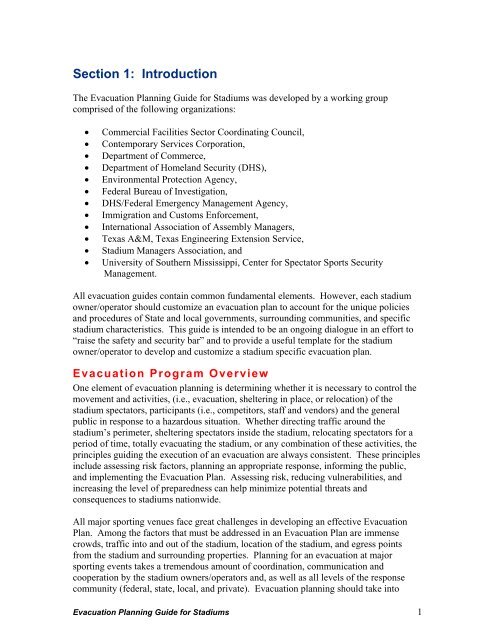Evacuation Planning Guide for Stadiums
Evacuation Planning Guide for Stadiums
Evacuation Planning Guide for Stadiums
You also want an ePaper? Increase the reach of your titles
YUMPU automatically turns print PDFs into web optimized ePapers that Google loves.
Section 1: Introduction<br />
The <strong>Evacuation</strong> <strong>Planning</strong> <strong>Guide</strong> <strong>for</strong> <strong>Stadiums</strong> was developed by a working group<br />
comprised of the following organizations:<br />
• Commercial Facilities Sector Coordinating Council,<br />
• Contemporary Services Corporation,<br />
• Department of Commerce,<br />
• Department of Homeland Security (DHS),<br />
• Environmental Protection Agency,<br />
• Federal Bureau of Investigation,<br />
• DHS/Federal Emergency Management Agency,<br />
• Immigration and Customs En<strong>for</strong>cement,<br />
• International Association of Assembly Managers,<br />
• Texas A&M, Texas Engineering Extension Service,<br />
• Stadium Managers Association, and<br />
• University of Southern Mississippi, Center <strong>for</strong> Spectator Sports Security<br />
Management.<br />
All evacuation guides contain common fundamental elements. However, each stadium<br />
owner/operator should customize an evacuation plan to account <strong>for</strong> the unique policies<br />
and procedures of State and local governments, surrounding communities, and specific<br />
stadium characteristics. This guide is intended to be an ongoing dialogue in an ef<strong>for</strong>t to<br />
“raise the safety and security bar” and to provide a useful template <strong>for</strong> the stadium<br />
owner/operator to develop and customize a stadium specific evacuation plan.<br />
<strong>Evacuation</strong> Program Overview<br />
One element of evacuation planning is determining whether it is necessary to control the<br />
movement and activities, (i.e., evacuation, sheltering in place, or relocation) of the<br />
stadium spectators, participants (i.e., competitors, staff and vendors) and the general<br />
public in response to a hazardous situation. Whether directing traffic around the<br />
stadium’s perimeter, sheltering spectators inside the stadium, relocating spectators <strong>for</strong> a<br />
period of time, totally evacuating the stadium, or any combination of these activities, the<br />
principles guiding the execution of an evacuation are always consistent. These principles<br />
include assessing risk factors, planning an appropriate response, in<strong>for</strong>ming the public,<br />
and implementing the <strong>Evacuation</strong> Plan. Assessing risk, reducing vulnerabilities, and<br />
increasing the level of preparedness can help minimize potential threats and<br />
consequences to stadiums nationwide.<br />
All major sporting venues face great challenges in developing an effective <strong>Evacuation</strong><br />
Plan. Among the factors that must be addressed in an <strong>Evacuation</strong> Plan are immense<br />
crowds, traffic into and out of the stadium, location of the stadium, and egress points<br />
from the stadium and surrounding properties. <strong>Planning</strong> <strong>for</strong> an evacuation at major<br />
sporting events takes a tremendous amount of coordination, communication and<br />
cooperation by the stadium owners/operators and, as well as all levels of the response<br />
community (federal, state, local, and private). <strong>Evacuation</strong> planning should take into<br />
<strong>Evacuation</strong> <strong>Planning</strong> <strong>Guide</strong> <strong>for</strong> <strong>Stadiums</strong> 1


